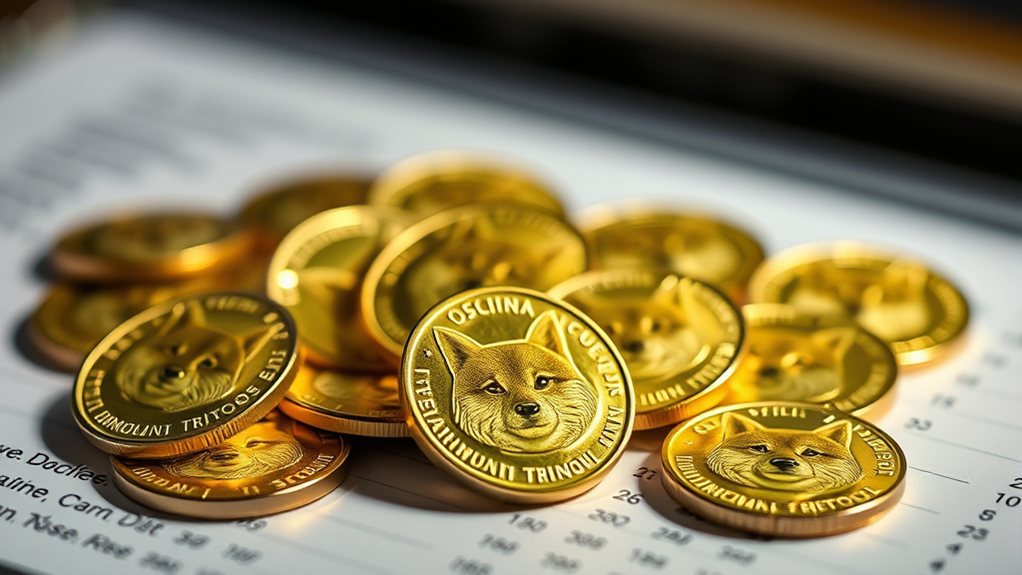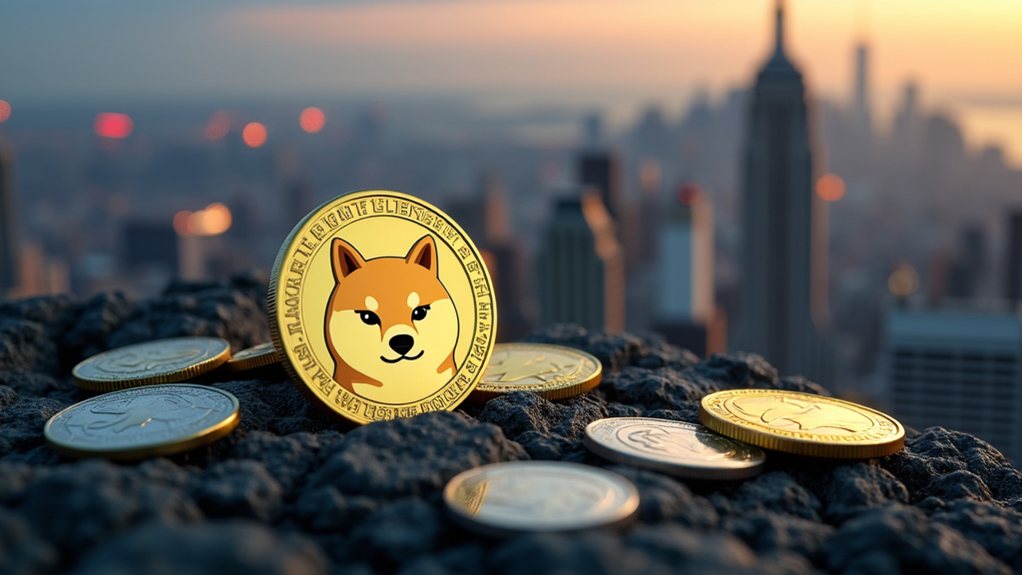Dogecoin ownership is highly concentrated, with 0.002% of wallets controlling about 66% of the supply. Cryptocurrency exchanges like Robinhood and Binance hold the largest portions, acting as custodians for users' coins. The top single wallet contains nearly 28% of all Dogecoin. Notable supporters include Elon Musk, Mark Cuban, and other celebrities, though their exact holdings aren't public. This concentration raises important questions about the cryptocurrency's market stability.

Where exactly does all that Dogecoin end up? The popular cryptocurrency's ownership is more concentrated than many realize. Just 0.002% of wallets control about 66% of all Dogecoin in circulation. This tiny fraction of holders, often called "whales," can influence the market considerably when they buy or sell.
The ultra-wealthy few control Dogecoin's fate, with a microscopic 0.002% of wallets holding two-thirds of all coins.
Cryptocurrency exchanges hold the largest portions of Dogecoin. Robinhood tops the list with roughly 30.9 billion DOGE in its exchange wallet. Binance follows with approximately 10.6 billion DOGE. Cryptsy Exchange holds about 5.03 billion DOGE. These exchanges aren't necessarily the owners but rather custodians for their users' coins.
Several unidentified individuals own massive amounts of Dogecoin. Two unknown wallets hold 8.9 billion and 4.78 billion DOGE respectively. The largest single wallet contains 27.95% of the total supply, which equals about 38.43 billion DOGE. The top 20 addresses collectively control over half of all Dogecoin.
Some companies have invested in Dogecoin too. Tesla, led by Elon Musk, owns an undisclosed amount. Spirit Blockchain Capital acquired holdings in late 2024. The Dogeparty Burn Address has about 1.8 billion DOGE permanently removed from circulation. Some businesses now accept Dogecoin as payment, including Mark Cuban's Dallas Mavericks.
Celebrities have shown interest in Dogecoin, though their exact holdings aren't public. Elon Musk is the most vocal supporter, frequently tweeting about it. Other celebrity backers include Mark Cuban, Snoop Dogg, and KISS bassist Gene Simmons. Glauber Contessoto, nicknamed the "Doge Millionaire," gained fame after claiming to make millions from his investment.
Dogecoin's network structure raises some concerns about decentralization. It has around 1,090 nodes compared to Bitcoin's 10,000. This makes it potentially more vulnerable to attacks. Mining is also concentrated among fewer entities than other cryptocurrencies.
Unlike Bitcoin, Dogecoin has no maximum supply cap. New coins are created constantly at a rate of 10,000 DOGE per block, mined approximately every minute. This adds about 14.4 million new coins daily, making Dogecoin inflationary by design. The cryptocurrency uses the Scrypt algorithm for its mining process, which was inherited from its Litecoin foundations.
The high concentration of ownership in few hands creates market risks. When large holders sell, prices can drop dramatically. This happened several times in Dogecoin's history. The coin's value remains heavily influenced by social media sentiment and celebrity endorsements rather than fundamental utility.
For average investors, understanding who controls the majority of Dogecoin helps explain its price volatility. While the cryptocurrency began as a joke in 2013, it's now a serious investment for many, despite its concentrated ownership structure. Approximately 4.8 million unique addresses hold Dogecoin, though this doesn't accurately reflect individual holder count since users may control multiple addresses.
Frequently Asked Questions
How Much Was Dogecoin Worth When It First Launched?
When Dogecoin first launched on December 6, 2013, it was fundamentally worthless, starting at $0.
Within days, it rose to about $0.0004. By January 23, 2014, its first officially recorded price was $0.001540753, equivalent to roughly 25 Indonesian Rupiah.
The price jumped 300% to $0.00095 on December 19, 2013, just weeks after launch, showing early investor interest in the meme cryptocurrency.
Can Dogecoin Ever Reach $10 in Value?
While Dogecoin reaching $10 is theoretically possible, it faces significant challenges.
At $10, Dogecoin's market cap would hit $1.4 trillion – larger than many major corporations combined. This would require:
- 5,800% price increase
- Massive mainstream adoption
- Overcoming its inflationary supply
- Development of practical use cases
Most analysts project more modest targets of $0.50-$1 by 2025, with $1-$5 possible by 2030.
What Gives Dogecoin Its Actual Value?
Dogecoin's value comes from market demand and social factors. Its large community, celebrity endorsements, and meme culture drive interest.
Businesses accepting DOGE as payment add practical value. Its technical features, like fast transactions and low fees, make it useful.
Unlike Bitcoin, Dogecoin doesn't have a supply cap. Instead, it relies on widespread adoption, utility, and continued public interest to maintain its market value.
How Does Dogecoin Mining Work?
Dogecoin mining uses the Scrypt proof-of-work algorithm. Miners solve complex puzzles to verify transactions and add blocks to the blockchain.
New blocks are created every minute with a fixed reward of 10,000 DOGE per block. Most miners use specialized ASIC hardware and join mining pools to increase their chances of earning rewards.
The process requires significant electricity and profitability depends on DOGE price and operational costs.
Is Dogecoin Environmentally Friendly Compared to Bitcoin?
Dogecoin is more environmentally friendly than Bitcoin, though neither is truly "green."
Dogecoin uses about 0.12 kWh per transaction compared to Bitcoin's 707 kWh. Its annual energy consumption is roughly 6 TWh versus Bitcoin's 110-150 TWh.
Dogecoin's carbon footprint is approximately 3 megatonnes CO2 annually, while Bitcoin produces 65-130 megatonnes.
Dogecoin's faster processing time (33 transactions per second vs. Bitcoin's 7) contributes to its lower environmental impact.










